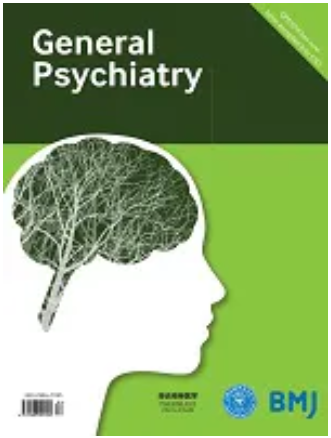经颅直流电刺激对下肢大关节成形术老年患者术后睡眠障碍的影响:一项前瞻性、双盲、试验性随机对照试验
IF 5.3
3区 医学
Q1 PSYCHIATRY
引用次数: 0
摘要
背景 手术后睡眠障碍(PSD)是一种常见且严重的术后并发症,与术后不良预后有关。目的 本研究旨在探讨经颅直流电刺激(tDCS)对下肢大关节成形术老年患者睡眠障碍的影响。方法 在这项前瞻性、双盲、试验性、随机、假对照试验中,65 岁及以上接受下肢大关节成形术的患者被随机分配接受主动 tDCS(a-tDCS)或假 tDCS(s-tDCS)。主要结果是术后第 1 夜和第 2 夜的客观睡眠测量。结果 对 116 名住院患者进行了资格评估,共有 92 名患者入选,其中 47 人接受了 a-tDCS 治疗,45 人接受了 s-tDCS。tDCS 通过改变 a-tDCS 组和 s-tDCS 组的以下睡眠指标来改善 PSD;各自的比较结果如下:促进 N1(64.5 (33.5-105.5) vs 19.0 (0.0, 45.0) min,F=20.10,p<0.001)和 N2(75.0 (36.0-120.8) vs 30.0 (1.3-59. 3) min,F=12.10,p<0.001)的快速眼动(REM)睡眠时间。3)分钟,F=12.55,p<0.001);N1(506.0(408.0-561.0) vs 392.0(243.0-483.5)分钟,F=14.13,p<0.001)和 N2(488.5(455.5-548.5) vs 346.0(286.5-517.5)分钟,F=7.36,p=0.007)的总睡眠时间;N1(130.0(103.3-177.0)vs 42.5(9.8-100.8)min,F=24.4,p<0.001)和 N2(103.5(46.0-154.8)vs 57.5(23.3-106.5)min,F=8.4,p=0.004)的深度睡眠时间;以及 N1 和 N2 的浅睡眠和快速动眼期睡眠百分比(均 p<0.05)。两组患者的术后抑郁和焦虑评分无明显差异。无重大不良事件报告。结论 在接受下肢大关节成形术的老年患者中,对左侧背外侧前额叶皮层进行一次阳极tDCS治疗,对改善术后短期客观睡眠指标有潜在的预防作用。不过,这种益处只是暂时的,并不能长期保持。如有合理要求,可提供相关数据。去身份化的个人临床数据将应相应作者的要求提供,仅用于学术或公共卫生机构附属个人的非商业性研究。本文章由计算机程序翻译,如有差异,请以英文原文为准。
Effect of transcranial direct current stimulation on postoperative sleep disturbance in older patients undergoing lower limb major arthroplasty: a prospective, double-blind, pilot, randomised controlled trial
Background Postoperative sleep disturbance (PSD) is a common and serious postoperative complication and is associated with poor postoperative outcomes. Aims This study aimed to investigate the effect of transcranial direct current stimulation (tDCS) on PSD in older patients undergoing lower limb major arthroplasty. Methods In this prospective, double-blind, pilot, randomised, sham-controlled trial, patients 65 years and over undergoing lower limb major arthroplasty were randomly assigned to receive active tDCS (a-tDCS) or sham tDCS (s-tDCS). The primary outcomes were the objective sleep measures on postoperative nights (N) 1 and N2. Results 116 inpatients were assessed for eligibility, and a total of 92 patients were enrolled; 47 received a-tDCS and 45 received s-tDCS. tDCS improved PSD by altering the following sleep measures in the a-tDCS and s-tDCS groups; the respective comparisons were as follows: the promotion of rapid eye movement (REM) sleep time on N1 (64.5 (33.5–105.5) vs 19.0 (0.0, 45.0) min, F=20.10, p<0.001) and N2 (75.0 (36.0–120.8) vs 30.0 (1.3–59.3) min, F=12.55, p<0.001); the total sleep time on N1 (506.0 (408.0–561.0) vs 392.0 (243.0–483.5) min, F=14.13, p<0.001) and N2 (488.5 (455.5–548.5) vs 346.0 (286.5–517.5) min, F=7.36, p=0.007); the deep sleep time on N1 (130.0 (103.3–177.0) vs 42.5 (9.8–100.8) min, F=24.4, p<0.001) and N2 (103.5 (46.0–154.8) vs 57.5 (23.3–106.5) min, F=8.4, p=0.004); and the percentages of light sleep and REM sleep on N1 and N2 (p<0.05 for each). The postoperative depression and anxiety scores did not differ significantly between the two groups. No significant adverse events were reported. Conclusion In older patients undergoing lower limb major arthroplasty, a single session of anodal tDCS over the left dorsolateral prefrontal cortex showed a potentially prophylactic effect in improving postoperative short-term objective sleep measures. However, this benefit was temporary and was not maintained over time. Data are available upon reasonable request. De-identified individual clinical data will be made available upon request to the corresponding authors only for non-commercial research to individuals affiliated with academic or public health institutions.
求助全文
通过发布文献求助,成功后即可免费获取论文全文。
去求助
来源期刊

General Psychiatry
医学-精神病学
CiteScore
21.90
自引率
2.50%
发文量
848
期刊介绍:
General Psychiatry (GPSYCH), an open-access journal established in 1959, has been a pioneer in disseminating leading psychiatry research. Addressing a global audience of psychiatrists and mental health professionals, the journal covers diverse topics and publishes original research, systematic reviews, meta-analyses, forums on topical issues, case reports, research methods in psychiatry, and a distinctive section on 'Biostatistics in Psychiatry'. The scope includes original articles on basic research, clinical research, community-based studies, and ecological studies, encompassing a broad spectrum of psychiatric interests.
 求助内容:
求助内容: 应助结果提醒方式:
应助结果提醒方式:


